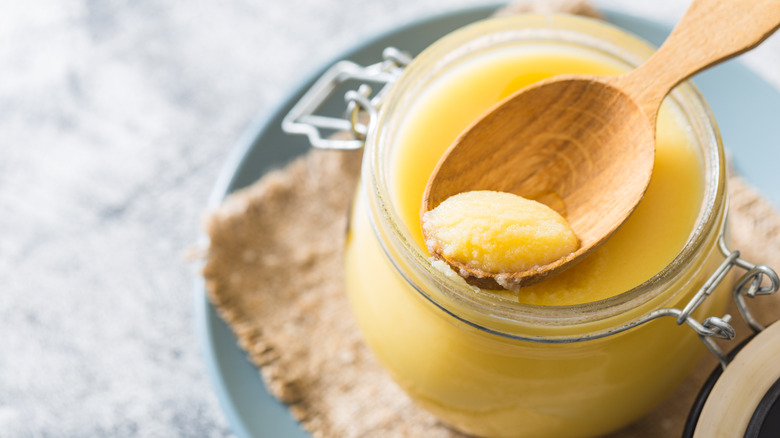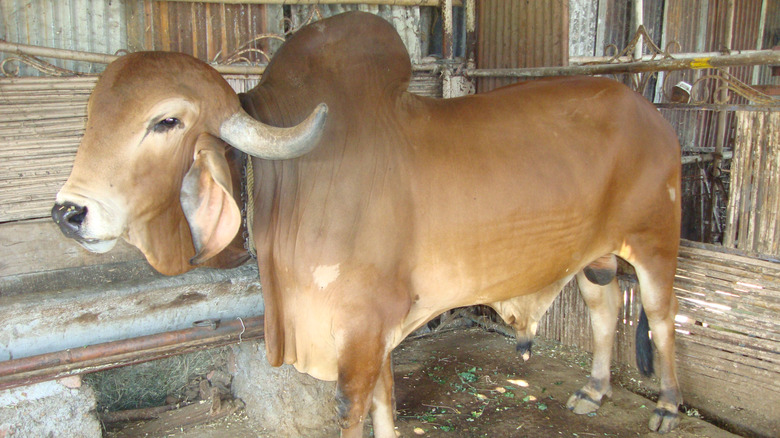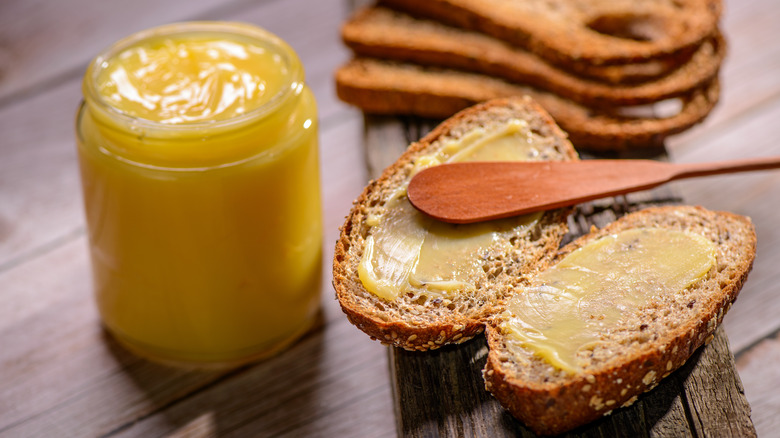How Is A2 Ghee Different From The Regular Variety?
It may look like butter and share many culinary applications, but there is a notable distinction between that pale yellow stick of butter in your fridge and a jar of liquid gold ghee. Ghee is made by gently heating butter until the water evaporates and milk solids separate. Those solids, which are proteins and sugars, are then skimmed or strained, and the resulting liquid is just pure butterfat we know as ghee. Ghee is different from clarified butter in that it is heated longer, allowing the milk solids to brown, which is what's responsible for the golden hue and nutty flavor (via Master Class).
Ghee has been a sacred staple in Indian cuisine for eons and is attributed with presenting many health and cooking benefits. It has a higher smoke point than butter, making it suitable for frying and roasting. Due to the removal of the casein protein and lactose sugar when ghee is made, many people who experience digestive distress when consuming dairy are able to consume ghee with no issues.
Within the world of ghee, there are several varieties — from grass-fed to flavored to A2. The A2 label is growing in popularity thanks to a myriad of health claims. But what exactly is it, and how does it differ from regular ghee?
It starts with the cow
A1 and A2 are the two main protein types found in milk. Historically, cows from Africa and Asia produced milk with A2 proteins. As inhabitants migrated to other parts of the world, they began breeding those cows to be stronger and produce more milk. As breeding continued over time, a genetic mutation developed in the cows, and they began to produce the A1 protein in their milk. As a result, many of the cows today are hybrids and produce half A1 and half A2 milk. (via Pure Indian Foods).
Regular variety ghee is made from regular milk, which comes from these modern-day hybrid cows. Most of the milk, butter, and ghee you see on store shelves are from hybrid cows and contain A1 and A2 proteins unless labeled otherwise. Older breeds of cows still produce solely A2 protein milk. Desi breed, or A2 cows, are not the standard black and white spotted animal we pass grazing on grass while driving through the countryside. A2 milk cows have a large hump, longer necks, and long, curved horns, per Shahji Ghee.
Research has shown that A1 protein milk may be linked to health issues. A study published in Nutrition Journal in 2016 concluded that A1 milk is associated with gastrointestinal inflammation and cognitive disturbances. As a result, A2 milk and its derivatives, such as ghee, are popping up on more and more store shelves.
A2 ghee benefits
A2 ghee is made from the milk of Desi cows only. These are purebred animals that were never crossbred and, therefore, never subjected to developing the A1 mutation.
Ghee made from these cows contains higher amounts of vitamins, antioxidants, and fatty acids than that from hybrid cows. The hump unique to Desi cows stores vitamin D. A2 milk has been shown to enhance immunity and brain health due to the presence of strontium and cerebrosides. The milk contains colostrum, which makes it similar to human breast milk. A2 products are also easier to digest than the A1 variety. The cows themselves are much less prone to diseases; however, they produce less milk and cost more to maintain (via Shahji Ghee).
Since the milk solids are removed in the process of making ghee, and that is where the A1 and A2 proteins reside, does it have much of an effect on the final product? Per Pure Indian Foods, as there are likely small traces of milk solids left behind in the making of ghee, those with a severe allergy to dairy may want to avoid ghee altogether. Those sensitive to A1, in particular, may want to stick to the Desi cow, A2 variety.


